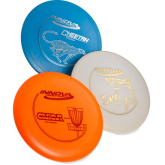 Disc types
Disc types
The golf discs used today are much smaller and heavier than traditional flying discs, typically about 8 or 9 inches in diameter and weighing between 150 and 180 grams. The PDGA prohibits any disc to be heavier than 200 grams. Discs used for disc golf are designed and shaped for control, speed, and accuracy while general-purpose flying discs, such as those used for playing guts or ultimate, have a more traditional shape, similar to a catch disc. There is a wide variety of discs used in disc golf and they are generally divided into three categories: putters, all-purpose mid-range discs, and drivers.
Putter
Putters are similar to the discs used in simple games of catch, such as the Wham-o brand Frisbee. They are designed to fly straight, predictably, and very slowly compared to mid-range discs and drivers. They are typically used for tight, controlled shots that are close to the basket, although some players use them for short drives where trees or other obstacles come into play. Usually a pro carries 1-7 putters depending on their flight characteristics.
Mid-Range
Mid-range discs have slightly sharper edges that enable them to cut through the air better. These discs are usually more stable than a driver and have a more stable and predictable flight path. They are faster and have a longer range than a putter. Some players will use mid-ranges as drivers, and there are tournaments that require players to use only mid-range discs. They are good all-around discs and are suitable for a first time player.
Driver
Drivers are usually recognized by their sharp, bevelled edge and have most of their mass concentrated on the outer rim of the disc rather than distributed equally throughout. Drivers are often divided into different categories. For example, Innova Discs divides their discs into Distance Drivers and Fairway Drivers, with a fairway driver being somewhere between a distance driver and a mid-range disc. Discraft divides their drivers into 3 categories: Long Drivers, Extra Long Drivers, and Maximum Distance Drivers. Because the physics of a disc require "snap" or "flick", which means putting spin on the disc, new players generally find that throwing a distance driver accurately can be somewhat difficult and will require experience with disc golf disc response. This is why it is better for players to begin with fairway drivers, long drivers, or even mid-ranges, and incorporate maximum distance drivers as their strength and disc control increases.Most players that are starting off will be most likely throwing lighter discs. Another type of driver, used less frequently, is a roller. As the name indicates, it has an edge designed to roll rather than fly.
Stability
The stability rating of the discs differs depending on the manufacturer of the disc. Innova Discs rate stability as "turn" on a scale of +1 to -4, where +1 is the most overstable and -4 is the most understable. These ratings can be found on the discs themselves or from the manufacturer's web site. Discraft prints the stability rating on all discs and also provides this information on their web site. The stability ranges from 3 to -2 for Discraft discs.
